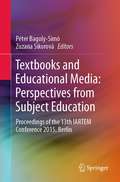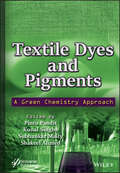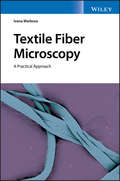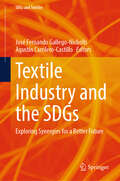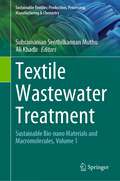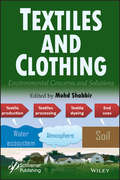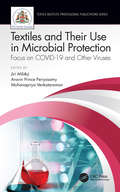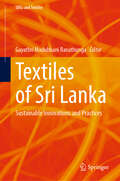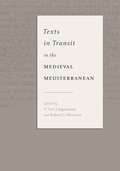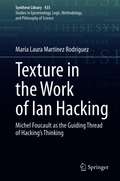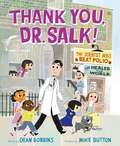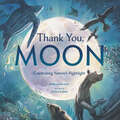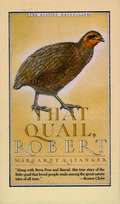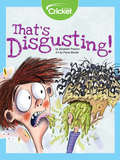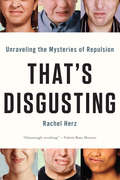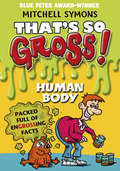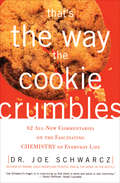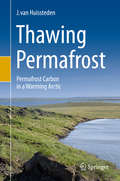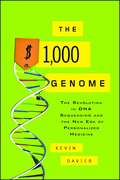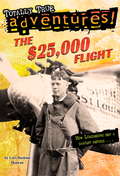- Table View
- List View
Textbooks and Educational Media: Proceedings of the 13th IARTEM Conference 2015, Berlin
by Péter Bagoly-Simó Zuzana SikorováThis book brings together empirical research and conceptual work on textbooks and education media from 13 countries and 17 disciplines. Along with textbook production, usage, and development, it also explores the interconnectedness of (educational) policy and teaching and learning materials. Further, the book offers insights into regional and local discourses (e.g. specific theories of Portuguese- and Spanish-speaking countries as well as Nordic countries, contrasting their theories with international literature), practices, and solutions with regard to teaching selected subjects at the pre-primary, primary, secondary, and tertiary level. This book also discusses the specific combinations of subjects (e.g. Physics, Biology, Geography, Swedish, English) and their subject-specific education (e.g. Physics Education or Didactics). Lastly, it examines the work of a number of early-career researchers, giving them a voice and bringing in fresh ideas currently being developed in various countries around the globe.This proceedings volume will appeal to publishers, subject educators in primary, secondary, and tertiary education, and academic researchers from the fields of textbooks, educational media and subject-specific education. Its international authorship and explicit focus on subject-specific particularities of educational media provide a unique and comprehensive overview.
Textile Dyes and Pigments: A Green Chemistry Approach
by Shakeel Ahmed Pintu Pandit Kunal Singha Subhankar MaityTextile Dyes and Pigments The book covers the best possible innovation and advancement in dyes and pigments for application in textile materials. Green chemistry can be applied across the life cycle of a chemical-intensive product, including its design, manufacture, use, and ultimate disposal. Innovations to green approaches are required either by developing a whole new set of eco-friendly dyes and pigments or by developing and designing unique dyeing methods. Textile Dyes and Pigments: A Green Chemistry Approach is a response to the many industries currently using conventional textile dyeing and pigmentation methods that are looking for sustainable green chemical options. It describes the various organic and inorganic color pigments and recent developments in vat, reactive, disperse, acid, and azo dyes and their importance in the field of green chemistry. It also covers the various challenges, opportunities, approaches, techniques, marketing, and alternative procedures/sustainable routes involved in developing textile dyes and pigments with green practices. Moreover, the book addresses the structure, process, and the nitty-gritty of modern dyes and pigments in the textile and garment sectors. Audience The book will be of prime interest to researchers and industry manufacturers and engineers in dyes, pigments, textile processing technology, fiber technology, and textile chemistry. It will also be an invaluable reference guide to new scholars and industry personnel who wish to learn about green dyes and pigments and their relevant application processes.
Textile Fiber Microscopy: A Practical Approach
by Ivana MarkovaA groundbreaking text to the study of textile fibers that bridges the knowledge gap between fiber shape and end uses Textile Fiber Microscopy offers an important and comprehensive guide to the study of textile fibers and contains a unique text that prioritizes a review of fibers’ microstructure, macrostructure and chemical composition. The author – a noted expert in the field – details many fiber types and includes all the possible fiber shapes with a number of illustrative micrographs. The author explores a wealth of topics such as fiber end uses, fiber source and production, a history of each fiber and the sustainability of the various fibers. The text includes a review of environmentally friendly fibers and contains information on the most current fiber science by putting the focus on fibers that have been mechanically or chemically recycled, for use in textile production. The author also offers an exploration of issues of textile waste and the lack of textile recycling that can help public policymakers with ways to inform and regulate post-industrial and post-consumer textile waste issues. This vital guide: Contains an accompanied micrograph for many fibers presented Includes information on how fiber microstructure is connected to fabric properties and how it affects the end use of fabrics Offers a review of the sophistication of textile fibers from a scientific point of view Presents a comparative textile fiber review that is appropriate for both for students, textile experts and forensic scientists Written for students and professionals of apparel design and merchandising, and forensic scientists, Textile Fiber Microscopy presents an important review of textile fibers from a unique perspective that explores fibers’ microstructure, macrostructure and chemical composition.
Textile Industry and the SDGs: Exploring Synergies for a Better Future (SDGs and Textiles)
by José Fernando Gallego-Nicholls Agustín Carrilero-CastilloThis book offers an exploration of the textile industry and their relationship to the Sustainable Development Goals (SDGs), catering specifically to academic researchers and providing a roadmap for aligning aligning textile research with the SDGs. It covers a wide range of topics, starting with an overview of the SDGs and their relevance to the textile industry. It examines the environmental footprint of textiles, including issues related to raw material sourcing, manufacturing processes, and waste management. Additionally, it explores the social and economic aspects of textiles, such as labor conditions, fair trade, and responsible consumption. One of the main focuses of this book is the role of innovation and technology in advancing sustainable textiles. It discusses emerging materials and technologies that promote circularity, reduce environmental harm, and enhance social well-being. Furthermore, it explores the potential of digitalization, artificial intelligence, and data analytics in optimizing textile production, distribution, and consumption patterns. This book also addresses the challenges and opportunities associated with sustainable textile supply chains. It analyzes the complexities of global value chains, the need for transparency and traceability, and the importance of collaboration among stakeholders. Furthermore, it highlights strategies for promoting sustainable fashion, encouraging responsible consumption, and fostering circular business models. By delving into these topics, this book aims to solve several key problems faced by academic researchers in the field of textiles and sustainability. It provides a holistic understanding of the SDGs and their integration into textile research, helping researchers align their work with broader sustainability objectives. It offers insights into the latest innovations and technologies, enabling researchers to explore cutting-edge solutions for sustainable textiles. Additionally, it presents case studies and best practices from industry leaders, inspiring researchers to undertake impactful research and contribute to positive change. This book is intended for academic researchers, as well as practitioners, specializing in textiles, sustainability, and related fields. It serves as a valuable resource for professors, postgraduate students, and professionals seeking to deepen their knowledge of the interplay between textiles and the SDGs. It encourages critical thinking, fosters interdisciplinary collaboration, and equips researchers with the tools and insights necessary to drive sustainable transformations within the textile industry and beyond.
Textile Wastewater Treatment: Sustainable Bio-nano Materials and Macromolecules, Volume 1 (Sustainable Textiles: Production, Processing, Manufacturing & Chemistry)
by Subramanian Senthilkannan Muthu Ali KhadirIn this first volume, various materials such as chitosan, lignin-based biomaterials, cellulosic based bio materials, carbon materials, Polysaccharide-composites materials, Aromatic-Based Synthetic Macromolecules, Agricultural wastes, etc for treating textile waste water are highlighted. One of the major pollutants in the textile and fashion industry is (textile) waste water. Textile wastewater can lead to serious environmental issues if discharged without proper and sufficient treatment. The materials employed along with the technologies available to trate waste water are the key. There are a lot of advancements in terms materials, technologies employed for textile waste water treatment. Sustainable bio-nano materials and macro molecules play a major role in the efficient treatment of textile waster.
Textile Wastewater Treatment: Sustainable Bio-nano Materials and Macromolecules, Volume 2 (Sustainable Textiles: Production, Processing, Manufacturing & Chemistry)
by Subramanian Senthilkannan Muthu Ali KhadirIn this second volume, various materials such as Magnetic-based biocomposites, wheat bran/straw-based biomaterials, peel-based biomaterials, luffa Based Biomaterials, composite polymeric membranes, rice husk, hydroxyapatite etc for treating textile waste water are highlighted. One of the major pollutants in the textiles and fashion sector is textile waste water. Textile wastewater can lead to serious environmental issues if discharged without proper and sufficient treatment. The materials employed along with the technologies available to trate the waste water are the key. There are a lot of advancements in terms materials, technologies employed for textile waste water treatment. Sustainable bio-nano materials and macro molecules play a major role in the efficient textile waste treatment.
Textiles and Clothing: Environmental Concerns and Solutions
by Mohd ShabbirGreater emphasis needs to be placed on research into eco-friendly processes particularly suited for the textile industry. With this goal in mind, all environmental aspects relating to the textile and clothing industry are discussed in this book. Included in the 11 informative chapters herein are topics covering the correlation between the environment and the processing and utilization of textiles and clothing. Chapter 1 discusses the direct impact that the textile industry has on the environment. The hazardous environmental consequences that synthetic dyes used to color textiles have on the environment are highlighted in Chapter 2. Greener alternatives to dyeing are discussed in Chapters 3 through 5, and eco-friendly ways of finishing textiles are discussed in Chapters 6 and 7. Finally, solutions to address the environmental hazards associated with the textile industry are presented in Chapters 8 through 11.
Textiles and Their Use in Microbial Protection: Focus on COVID-19 and Other Viruses (Textile Institute Professional Publications)
by Aravin Prince Periyasamy Mohanapriya Venkataraman Jiri MilitkýTextiles and Their Use in Microbial Protection: Focus on COVID-19 and Other Viruses provides readers with vital information about disinfection mechanisms used in textile applications in the fight against dangerous microbes and viruses. KEY FEATURES: Introduces the basics of textile materials used for medical applications Features key information on virology, characterization, indication, and passivation of COVID-19 Describes UV, photocatalysis, photooxidation, application of TiO2, copper-based viral inhibition, and activated carbon Discusses antiviral finishes for the protection against SARS-CoV-2, particle penetration in dense cotton fabrics under swollen state, and the impact of moisture on face masks and their designs Aimed at textile and materials engineers as well as readers in medical fields, this text offers a comprehensive view of fundamentals and solutions in the use of textiles for microbial protection.
Textiles of Sri Lanka: Sustainable Innovations and Practices (SDGs and Textiles)
by Gayathri Madubhani RanathungaThis book highlights the role of sustainable development in ancient practices to modern innovations in the textiles of Sri Lanka. It reveals the textile of Sri Lanka from the historical age to current tech-fabrics. Supporting the sustainable development goals, this book covers the most sought-after concepts and practices in textile industry of Sri Lanka such as of maximum utilization, zero waste, eco-friendly production process, reuse, upcycling, recycling, and longevity. Various topics covered in this book are indigenous cultural textiles, women empowerment, agro-waste utilization, secondhand-fashion consumption, and many more. The book is a valuable reference for beginners, university students, researchers, and professionals interested in sustainable development in textiles and allied fields.
Texts in Transit in the Medieval Mediterranean
by Y. Tzvi Langermann Robert G. MorrisonThis collection of essays studies the movement of texts in the Mediterranean basin in the medieval period from historical and philological perspectives. Rejecting the presumption that texts simply travel without changing, the contributors examine closely the nature of these writings, which are concerned with such topics as science and medicine, and how they changed over the course of their journeys. Transit and transformation give texts new subtexts and contexts, providing windows through which to study how memory, encryption, oral communication, cultural and religious values, and knowledge traveled and were shared, transformed, and preserved. This volume broadens how we think about texts, communication, and knowledge in the medieval world.Aside from the editors, the contributors are Mushegh Asatryan, Brian N. Becker, Leonardo Capezzone, Leigh Chipman, Ofer Elior, Zohar Hadromi-Allouche, B. Harun Küçük, Israel M. Sandman, and Tamás Visi.
Texts in Transit in the Medieval Mediterranean
by Y. Tzvi Langermann, Robert G. MorrisonThis collection of essays studies the movement of texts in the Mediterranean basin in the medieval period from historical and philological perspectives. Rejecting the presumption that texts simply travel without changing, the contributors examine closely the nature of these writings, which are concerned with such topics as science and medicine, and how they changed over the course of their journeys. Transit and transformation give texts new subtexts and contexts, providing windows through which to study how memory, encryption, oral communication, cultural and religious values, and knowledge traveled and were shared, transformed, and preserved. This volume broadens how we think about texts, communication, and knowledge in the medieval world.Aside from the editors, the contributors are Mushegh Asatryan, Brian N. Becker, Leonardo Capezzone, Leigh Chipman, Ofer Elior, Zohar Hadromi-Allouche, B. Harun Küçük, Israel M. Sandman, and Tamás Visi.
Texture in the Work of Ian Hacking: Michel Foucault as the Guiding Thread of Hacking’s Thinking (Synthese Library #435)
by María Laura Martínez RodríguezThis book offers a systematized overview of Ian Hacking's work. It presents Hacking’s oeuvre as a network made up of four interconnected key nodes: styles of scientific thinking & doing, probability, making up people, and experimentation and scientific realism.Its central claim is that Michel Foucault’s influence is the underlying thread that runs across the Canadian philosopher’s oeuvre. Foucault’s imprint on Hacking’s work is usually mentioned in relation to styles of scientific reasoning and the human sciences. This research shows that Foucault’s influence can in fact be extended beyond these fields, insofar the underlying interest to the whole corpus of Hacking’s works, namely the analysis of conditions of possibility, is stimulated by the work of the French philosopher.Displacing scientific realism as the central focus of Ian Hacking’s oeuvre opens up a very different landscape, showing, behind the apparent dispersion of his works, the far-reaching interest that amalgamates them: to reveal the historical and situated conditions of possibility for the emergence of scientific objects and concepts.This book shows how Hacking’s deployment concepts such as looping effect, making up people, and interactive kinds, can complement Foucauldian analyses, offering an overarching perspective that can provide a better explanation of the objects of the human sciences and their behaviors.
Thank God for Evolution: How the Marriage of Science and Religion Will Transform Your Life and Our World
by Michael DowdFew issues have revealed deeper divisions in our society than the debate between creationism and evolution, between religion and science. Yet from the fray, Reverend Michael Dowd has emerged as a reconciler, finding faith strengthened by the power of reason. With evidence from contemporary astrophysics, geology, biology, anthropology, and evolutionary psychology, Thank God for Evolution lays out a compelling argument for how religion and science can be mutually enriching forces in our lives. Praised by Nobel laureates in the scientific community and religious leaders alike, Thank God for Evolution will expand the horizon of what is possible for self, for relationships, and for our world.
Thank You, Dr. Salk!: The Scientist Who Beat Polio and Healed the World
by Dean RobbinsDr. Jonas Salk finds the cure for polio in this inspiring, educational, and timely nonfiction picture book.Jonas Salk wasn't seen as a brave hero—not at first. As a child he was quiet and unassuming, but Jonas dreamed of tikkun olam, the Jewish phrase for “healing the world.” He saw the polio virus strike his city, and he knew that with determination and hard work, he could be the one to stop its spread. So he grew up to study medicine, ultimately creating the polio vaccine that saved untold numbers of lives—and healed the world!With Dean Robbins’s inspiring text and Mike Dutton’s dynamic illustrations, Thank You, Dr. Salk! is a true and timely story of trials, triumph, and what it takes to achieve your dreams. An author’s note provides additional insight into Dr. Salk’s life and influences, and the history of vaccines.
Thank You, Moon: Celebrating Nature's Nightlight
by Melissa StewartWith the soothing rhythm of a bedtime story and the scientific wonder of a nature doc, comes a celebration of the moon and all the creatures who rely on its light to find their way home.Under the glow of a shimmering moon, creatures great and small creep out of their dens, using its light to hunt, fend off predators, build their nests or build families. As the moon changes phases these animals adapt their behavior to match its waxing and waning—while human animals look on in wonder.As Earth's closest companion in space, the moon has fascinated humankind for generations, and this nonfiction picture book sheds light on the mysterious ways it affects life on Earth. With luminous illustrations by Jessica Lanan and a lyrical text that is part lullaby and part scientific resource, Thank You, Moon is a treasure for all ages to enjoy.
Thank You, Tree: A Board Book
by Editors of Storey PublishingOn every page of this beautiful board book, Fiona Lee's charming illustrations invite little ones to celebrate a wonderful tree, learn its name, and say thank you for the tree&’s joyful, natural gifts. From thanking a magnolia tree for its pink blossoms and a birch tree for a branch to swing on to thanking a maple tree for its colorful fall leaves and a cedar for a secret hiding place, this sweet book teaches the youngest readers to celebrates trees for their leaves, branches, flowers, fruits, and more.
That Crazy Eddie and the Science Project of Doom
by Judy CoxBest friends Matt and Eddie have a falling out that threatens to ruin their science fair project. Includes instructions for making a model of an erupting volcano.
That Quail, Robert
by Margaret A. StangerThe perennially bestselling and acclaimed classic of the little bird who preferred human companionship to other quail.
That's Disgusting
by Elizabeth Preston Paula BeckerHave you ever wondered why you get grossed out by different things? Everyone has had that feeling in their stomach when they are grossed out. Sometimes it can give you a stomachache or it can even make you get sick! Both people and animals can get disgusted by a wide range of things. Do you know you feel this way at times? Well, this story can help you learn how these feelings are a response that allows you to stay healthy and keep germs out of your body!
That's Disgusting: Unraveling the Mysteries of Repulsion
by Rachel Herz"A lively look at all things revolting."--New York Times Why do we watch horror movies? What is the best way to persuade someone to quit smoking? Why are we more likely to buy a given item if an attractive person has just touched it? And what on earth is the appeal of competitive eating? In this lively, colorful new book, Rachel Herz answers these questions and more, shedding light on an incredible range of human traits--from food preferences and sexual attraction to moral codes and political ideology--by examining them through the lens of a fascinating subject: disgust. One of the most complex human emotions, disgust is the product of both culture and instinct and so it allows us a unique perspective on the relationship between nature and nurture. A component of fear and prejudice, it also gives us powerful--sometimes disturbing--insights into the fabric of society. Herz draws on the latest psychological studies and neurological research to offer surprising observations about human behavior and biology. For example, we learn that a man's scent matters more than his looks or his income in determining whether or not a given woman will find him attractive, that lust and disgust activate the same area of the brain, and that watching a gory movie triggers your immune system as if you were facing an actual threat. We even learn that washing your hands after thinking about a past misdeed--a la Lady Macbeth--can help you feel less guilty. What makes That's Disgusting so remarkable is Herz's ability to weave these curious findings and compelling facts into a narrative that tackles important questions. What matters more: our brain wiring or our upbringing? Is there such a thing as "normal"? And how might politicians and marketers use disgust to manipulate us? Combining lucid scientific explanations and fascinating research with a healthy dose of humor, That's Disgusting illuminates issues that are central to our lives: love, hate, fear, empathy, prejudice, humor, and happiness.
That's So Gross!: Human Body (That's So Gross! #4)
by Mitchell SymonsNOXIOUS NOISES AND STINKY SMELLS . . .Amaze your mates with top trivia such as:Why do we puke and sweat?Which tribe uses farting as a greeting?How likely are you to be injured by a toilet seat?
That's the Way the Cookie Crumbles: 62 All-New Commentaries on the Fascinating Chemistry of Everyday Life
by Dr. Joe SchwarczThe bestselling popular science author reveals &“the connections between what we teach in chemistry courses and the world in which . . . [we] live&” (ChemEd X). Interesting anecdotes and engaging tales make science fun, meaningful, and accessible. Separating sense from nonsense and fact from fiction, these essays cover everything from the ups of helium to the downs of drain cleaners, and provide answers to numerous mysteries, such as why bug juice is used to color ice cream and how spies used secret inks. Mercury in teeth, arsenic in water, lead in the environment, and aspartame in food are also discussed. Mythbusters include the fact that Edison did not invent the light bulb and that walking on hot coals does not require paranormal powers. The secret life of bagels is revealed, and airbags, beer, and soap yield their mysteries. These and many more surprising, educational, and entertaining commentaries show the relevance of science to everyday life. &“A delightful and informative read. Dr. Schwarcz tells it like it is, whether the subject is light at heart or as weighty as death.&” —The Cosmic Chemist &“Fascinating [this book] is, thanks to the author&’s lively style and contagious enthusiasm for chemistry, and his ability to make it accessible . . . connects the dots between such unlikely events as the madness of King George III and the royal fondness for sauerkraut; and between gluten, the molecular make-up of trans-fatty acids, and how the cookie crumbles.&” —Montreal Review of Books
Thawing Permafrost: Permafrost Carbon in a Warming Arctic
by J. van HuisstedenThis book provides a cross-disciplinary overview of permafrost and the carbon cycle by providing an introduction into the geographical distribution of permafrost, with a focus on the distribution of permafrost and its soil carbon reservoirs. The chapters explain the basic physical properties and processes of permafrost soils: ice, mineral and organic components, and how these interact with climate, vegetation and geomorphological processes. In particular, the book covers the role of the large quantities of ice in many permafrost soils which are crucial to understanding carbon cycle processes.An explanation is given on how permafrost becomes loaded with ice and carbon. Gas hydrates are also introduced. Structures and processes formed by the intense freeze-thaw action in the active layer are considered (e.g. ice wedging, cryoturbation), and the processes that occur as the permafrost thaws, (pond and lake formation, erosion).The book introduces soil carbon accumulation and decomposition mechanisms and how these are modified in a permafrost environment. A separate chapter deals with deep permafrost carbon, gas reservoirs and recently discovered methane emission phenomena from regions such as Northwest Siberia and the Siberian yedoma permafrost.
The $1,000 Genome
by Kevin DaviesIn 2000, President Bill Clinton signaled the completion of the Human Genome Project at a cost in excess of $2 billion. A decade later, the price for any of us to order our own personal genome sequence--a comprehensive map of the 3 billion letters in our DNA--is rapidly and inevitably dropping to just $1,000. Dozens of men and women--scientists, entrepreneurs, celebrities, and patients--have already been sequenced, pioneers in a bold new era of personalized genomic medicine. The $1,000 genome has long been considered the tipping point that would open the floodgates to this revolution. Do you have gene variants associated with Alzheimer's or diabetes, heart disease or cancer? Which drugs should you consider taking for various diseases, and at what dosage? In the years to come, doctors will likely be able to tackle all of these questions--and many more--by using a computer in their offices to call up your unique genome sequence, which will become as much a part of your medical record as your blood pressure. Indeed, many experts are advocating that all newborns have a complete genome analysis done so that preventive measures and preemptive medicine can begin early in life. How has this astonishing achievement been accomplished? And what will it mean for our lives? To research the story of this unfolding revolution, critically acclaimed science writer Kevin Davies has spent the past few years traveling to the leading centers and interviewing the entrepreneurs and pioneers in the race to achieve the $1,000 genome. He vividly brings to life the extraordinary drama of this grand scientific achievement, revealing the masterful ingenuity that has transformed the process of decoding DNA and delivering the information it possesses to the public at large. Davies also profiles the future of genomic medicine and thoughtfully explores the many pressing issues raised by the tidal wave of personal genetic information. Will your privacy be protected? Will you be pressured, by insurance companies or by your employer, to get your genome sequenced? What psychological toll might there be to discovering you are at risk for certain diseases like Alzheimer's? And will the government or the medical establishment come between you and your genome?One thing that is not in question is that we are moving swiftly into the personalized medicine era, and The $1,000 Genome is an essential guide to this brave new future.
The $25,000 Flight
by Wesley Lowe Lori Haskins HouranThe most exciting adventures are the ones that really happened! This brand-new Totally True Adventures book follow America's first superstar pilot, Charles Lindbergh. In the 1920s, flying was brand new--and very dangerous. A $25,000 prize for the first flight from New York to Paris went unclaimed for years. Many teams tried. And many teams failed. Still, Charles Lindbergh felt he had a shot at the prize. He wasn't famous. He wasn't rich. But he was determined. He'd cross the ocean in a tiny plane . . . and he'd do it all by himself! After you've read the story, don't miss the bonus content with extra facts, a timeline, and more 20th century history, geography, and science-tie-ins!From the Trade Paperback edition.
